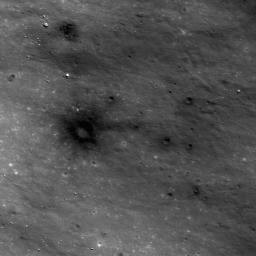
|
Dark Craters on a Bright Ejecta Blanket
- Click the image above for a larger view
- Full-Res JPEG (1000 x 1000) (110.6 kB)
- Full-Res TIFF (1000 x 1000) (1.0 MB)
Caption:
Dark materials excavated by later small impacts show up clearly on the bright ejecta of a small lunar crater (800 meters in diameter) to the west. Image width is 640 meters.
Lunar geologists are interested in all aspects of craters, including their formation, structure, and the materials that they excavate. In this view of the ejecta blanket of a small fresh crater in the farside highlands north of Jules Verne Z, we can see where small, presumably secondary craters (that is, impact craters formed by the ejecta that expelled from a larger crater) have punched through the thin ejecta blanket of this fresh crater and excavated the darker, more mature materials beneath.
Background Info:
NASA's Goddard Space Flight Center built and manages the mission for the Exploration Systems Mission Directorate at NASA Headquarters in Washington. The Lunar Reconnaissance Orbiter Camera was designed to acquire data for landing site certification and to conduct polar illumination studies and global mapping. Operated by Arizona State University, the LROC facility is part of the School of Earth and Space Exploration (SESE). LROC consists of a pair of narrow-angle cameras (NAC) and a single wide-angle camera (WAC). The mission is expected to return over 70 terabytes of image data.
Cataloging Keywords:
| Name | Value | Additional Values |
|---|---|---|
| Target | Moon | |
| System | Earth | |
| Target Type | Satellite | |
| Mission | Lunar Reconnaissance Orbiter (LRO) | |
| Instrument Host | Lunar Reconnaissance Orbiter | |
| Host Type | Orbiter | |
| Instrument | Lunar Reconnaissance Orbiter Camera (NAC) | |
| Detector | Narrow Angle Camera (NAC), Wide Angle Camera (WAC) | |
| Extra Keywords | Crater, Grayscale, Impact | |
| Acquisition Date | ||
| Release Date | 2009-11-16 | |
| Date in Caption | ||
| Image Credit | NASA/GSFC/Arizona State University | |
| Source | photojournal.jpl.nasa.gov/catalog/PIA12926 | |
| Identifier | PIA12926 | |
